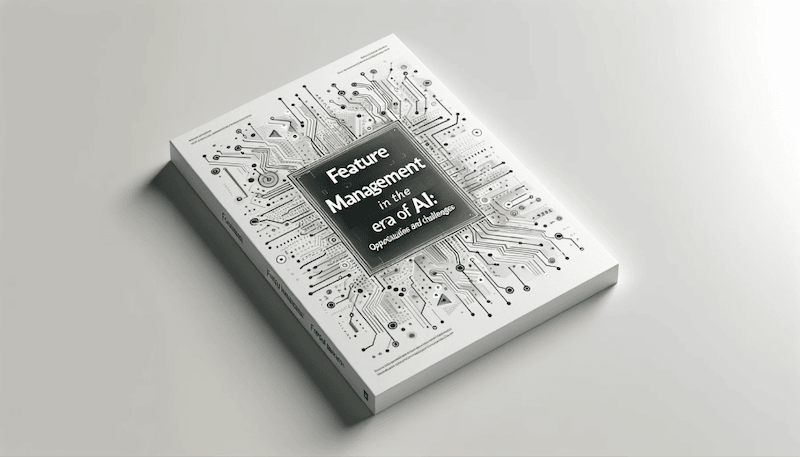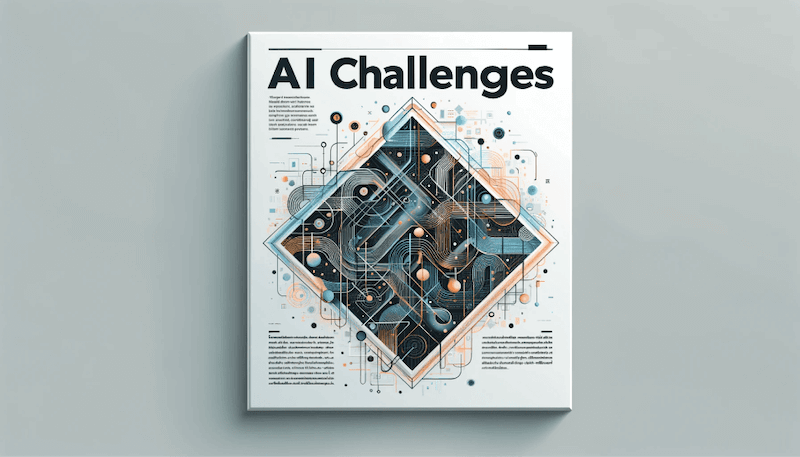Feature Management in the Era of AI - Opportunities and Challenges
The rise of AI in software development is reshaping the industry's landscape, redefining roles, and setting new benchmarks for efficiency, innovation, and creativity. Gone are the days when software development was exclusively the domain of developers meticulously crafting code, with the process steeped in manual oversight and prone to human error. The introduction of AI into this sphere has been akin to when factories started using assembly lines in manufacturing—revolutionizing productivity and output quality.
AI's role in software development has swiftly moved from a supportive backdrop to a central player, taking on tasks that once consumed countless hours of human labor. Its capabilities have snowballed, from analyzing vast data to identifying patterns, automating repetitive tasks, and even preempting developer actions by suggesting improvements and debugging possible errors or bugs. It has enabled developers to transcend traditional limitations, empowering them to innovate at an unprecedented pace and scale. Hence, AI has become a keystone in the quest for efficiency, precision, and speed in software development.

AI's integration into development processes has also catalyzed the emergence of new ways to leverage its strengths, predicated on its intelligent analysis and application of data models to enhance the software development lifecycle. One of these emerging advancements is in the innovative interplay between AI and feature management in reshaping how we create, deploy, and manage software and its associated features. While these advancements possess a wealth of potential, they also pose complexities and challenges that require thoughtful consideration and navigation.
Predictive Feature Flagging: Using AI to Predict Optimal Feature Releases
Feature flagging is a feature management technique used in software development to dynamically turn features on or off without redeploying the entire application, which allows developers to test changes in production with specific user segments, perform A/B testing, and roll out new features incrementally while mitigating deployment risks. Integrating AI into this process can improve the workflow to make it more efficient and automated.
Predictive feature flagging is one of such ways AI can be used to elevate feature management by facilitating the ability to predict the optimal time and manner to release new features; it's a bit like having an intelligent assistant to help decide when and how to introduce new features in a software application. This predictive model analyzes a wealth of data, including user behaviors or interactions, preferences, and feedback, alongside relevant trends or metrics to make predictive decisions.
Predicting and Personalizing Feature Releases
In the past, deciding when and how to release a new feature in an app was often based on a mix of experience and guesswork. It was a bit like trying to hit a moving target in the dark. However, with predictive feature flagging using AI, this process becomes more like turning on a light in that dark room by empowering decision-making with insights derived from comprehensive data analysis on how people use and interact with the software. These AI algorithms identify patterns and insights that humans might miss, like analyzing how people interact with different things in the app. Then, using this information, AI predicts how new features might perform when released to everyone.
Utilizing this method, you can also figure out when the best time is for a new feature to be released and the best group of users to try out the feature first. For example, an AI might suggest releasing a new feature on a specific weekday night if users are less active on the app during that particular weekday. AI can also personalize how features are released to different groups of users. Imagine you have a fitness app; AI might suggest initially releasing a new step-tracking feature to users who are already active joggers, but maybe not to those who use the app primarily for diet tracking initially to get more accurate feedback.
Predictive feature flagging isn't just about deciding when and what to release. It's also about learning from each release. Every time a feature is released, AI can gather more data about how users react and interact with it. This information helps it make even better predictions in the future. In other words, predictive feature flagging with AI has the potential to create a more responsive and adaptive feature release pipeline and make introducing new features safer and more user-centric. This is great for minimizing the uncertainties and risks of new features and understanding their potential impact before public release.
Automated A/B Testing: Leveraging AI for More Efficient Testing Scenarios

Effectively fine-tuning your product to optimize engagement with your audience often hinges on how well you can experiment with and optimize different features and elements of your application. This is where A/B testing plays a pivotal role by serving as a cornerstone and vital tool for businesses to compare two versions of a webpage or experiment with different implementations of features to determine which variations perform better.
However, conducting these experiments thoroughly and accurately is not a trivial task. It requires significant time and resources, often involving complex planning, execution, and analysis to yield meaningful results. AI can transform this landscape by turbocharging A/B tests to automate and enhance many aspects of the A/B testing process for more efficient testing scenarios. For instance, it can quickly generate multiple variations of web pages and content, predict outcomes based on historical data, or even analyze test results to extract insights more efficiently than manual methods.
By summarizing test outcomes and highlighting key findings, AI not only speeds up the analysis process but can also provide actionable insights for future strategies. This accelerates the learning and adaptation curve from each set of experiments to significantly reduce the time and effort traditionally required in A/B testing.
AI's Role in Overcoming A/B Testing Challenges
Another area where AI proves invaluable is in identifying optimization barriers in A/B testing. By analyzing user feedback and performance data, AI can quickly pinpoint areas hindering conversion rates and help businesses understand common pain points and preferences, allowing immediate action to enhance application performance or shape future A/B testing strategies. Furthermore, feeding competitor data into an AI can also enable businesses to gain insights into optimization strategies, keeping them ahead in an increasingly competitive market.
Moreover, many businesses lack the needed resources and traffic to conduct sufficient A/B tests. This lack makes achieving successful and consistent experiments to benefit from website optimization efforts challenging. Using AI tools, teams can examine key metrics, such as conversion rate, revenue, and retention, to see how they differ between variations.
You can also use them to spot anomalies, outliers, or trends in your data. The ability of AI to process and synthesize large datasets comes in handy in anticipating future trends, allowing businesses to tailor their tests more effectively. This predictive capacity not only helps conduct more focused and relevant experiments but also streamlines the optimization process to ensure that implementations and features remain at the forefront of your industry.
Potential Pitfalls and Considerations When Combining AI and Feature Management

Integrating AI with feature management opens up a realm of exciting opportunities. However, like adding a powerful engine to a car, ensuring that AI is safe and Synergizes well with existing systems is crucial.
Data Quality and Quantity: The Foundation of AI's Effectiveness
One of the primary challenges is the issue of data quality and quantity. AI systems require consistent and accurate data to learn effectively and make sound predictions. Insufficient or inaccurate data can lead to erroneous outcomes.
The Expertise Gap in AI Implementation
The complexity and rapid evolution of AI present another challenge: the expertise gap. Many software developers may not possess the necessary skills to implement AI effectively, leading to potential errors and inefficiencies in feature management.
Understanding AI Decision-Making: The 'Black Box' Problem
A significant hurdle is the 'black box' problem, where the reasoning behind AI's decisions is not always transparent or understandable, even to its creators. This lack of clarity can be problematic when using AI for critical decisions in feature management.
Bias in AI: Ensuring Fair and Balanced Decisions
Another important concern is the unintentional encoding of biases in AI systems. These biases can lead to unfair or imbalanced decisions, especially in feature management, where they might result in the development of features that disproportionately favor certain user groups.
Ethical and Legal Considerations in AI Deployment
Lastly, as AI assumes more responsibility in decision-making, ethical and legal considerations become increasingly important. Questions of accountability arise: who is responsible if an AI's decision leads to a software problem? Is it the developers, the company, or the AI itself?
Navigating these ethical waters and challenges can be tricky and requires careful planning and consideration. Nevertheless, addressing these challenges is critical to successfully harnessing the power of AI in feature management.
Conclusion
As AI tools become more sophisticated, the future of feature management is undeniably intertwined with it as it takes on more responsibilities in the development process, allowing developers to focus on creative and strategic tasks. The potential for AI to enhance feature management is immense; innovative techniques like predictive feature flagging and automated A/B testing only showcase a little of AI's potential to revolutionize how features are developed, tested, and rolled out.
AI's integration into feature management heralds a new age of efficiency and precision. The harmonious blend of human ingenuity and AI's capabilities will define the next generation of software development and feature management. However, developers and companies must approach this new era with a mindset of responsible AI use, ensuring that tomorrow's software is not just powerful but also equitable, transparent, and reliable.
ConfigCat is a developer-centric feature flag service with unlimited team size, awesome support, and a reasonable price tag. ConfigCat supports simple feature toggles, user segmentation, and A/B testing and has a generous free tier for low-volume use cases or those just starting out.
For more feature flagging goodies, stay connected to ConfigCat on X, Facebook, LinkedIn, and GitHub.
